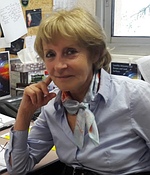2020 Vetlesen Winner Anny Cazenave on Encouraging Young Women Scientists
The Vetlesen Prize, established in 1959 by the G. Unger Vetlesen Foundation, is awarded for “scientific achievement resulting in a clearer understanding of the Earth, its history, or its relation to the universe.” The prize was designed to be the Nobel Prize of the Earth sciences.
After a three-year delay due to Covid, the 2020 Vetlesen Prize, administered by Columbia Climate School’s Lamont- Doherty Earth Observatory, was presented in April to French geophysicist Anny Cazenave who shared the stage with the 2023 recipient, physicist David Kohlstedt. Cazenave is a pioneer in the field of space geodesy, which uses satellites to measure the Earth’s shape, its orientation in space and its gravity field. Cazenave is an emeritus scientist at France’s Laboratory of Space Geophysical and Oceanographic Studies (LEGOS), and former director of the Earth sciences at the International Space Science Institute in Switzerland. She has spent more than two decades studying climate and environmental science with a focus on sea level rise and hydrology, the science concerned with properties of the Earth's water and its movement in relation to land.
In a recent Lamont release, Cazenave said, “During the 1970s, after receiving a PhD studying the Earth’s rotation, I was hired to work for CNES, the French Space Center. Space agencies were then working to quantify the forces acting on artificial satellites in order to accurately calculate their orbits. I began my research using different space geodesy techniques to determine the Earth’s gravity field, studying anomalies in the gravity field such as those in the internal structure of the Earth like vertical motions of the Earth’s crust and large-scale tectonic deformations.” In 1992, when TOPEX/Poseidon, a joint satellite altimeter mission between NASA and CNES, was launched to map ocean surface topography, Cazenave used satellite altimetry to measure climate-related sea level rise and its causes. Cazenave is also co-principal investigator of a European Research Council project studying the deep interior of the Earth using global observable measures such as the Earth’s magnetic and gravity fields and observations of the Earth’s rotation.
In the Lamont release, Cazenave also talked about the need to support young women in science. “The number of women in sciences has been growing in the past few decades in Europe, but (is) still incredibly low in some scientific areas and at top levels. I haven’t seen this as the result of sexism, but rather as complex cultural and societal factors subconsciously persuading women that scientific research is more appropriate for men. There’s also the struggle of childcare and family commitments. In France, I have benefited from a government system that offers women substantial support, including nurseries and recreation centers to take children during school holidays.”
“I believe senior women scientists like myself can help the younger generation in their scientific career path by teaching and supporting female PhD and postdocs at the research lab level. It is important to encourage junior scientists to apply for research grants, to share our scientific networks and assist them in navigating international meetings to increase their confidence and scientific visibility. More women scientists need to join scientific policy committees, to serve on panels that select grant and award winners, to increase the ratio of women in influential decision-making for the field.”
“Mentoring programs are helpful for younger women scientists but need to be better developed. Starting in childhood, education should teach children to move away from gender bias and stereotypes and to start scientific experimentation. Many countries, in the EU especially, have worked to teach kids that science is not just for boys, that girls and boys have similar intellectual abilities. Women scientists should attend meetings and exchanges with younger students. I visit colleges and high schools several times a year and find these interactions to be very gratifying.”


